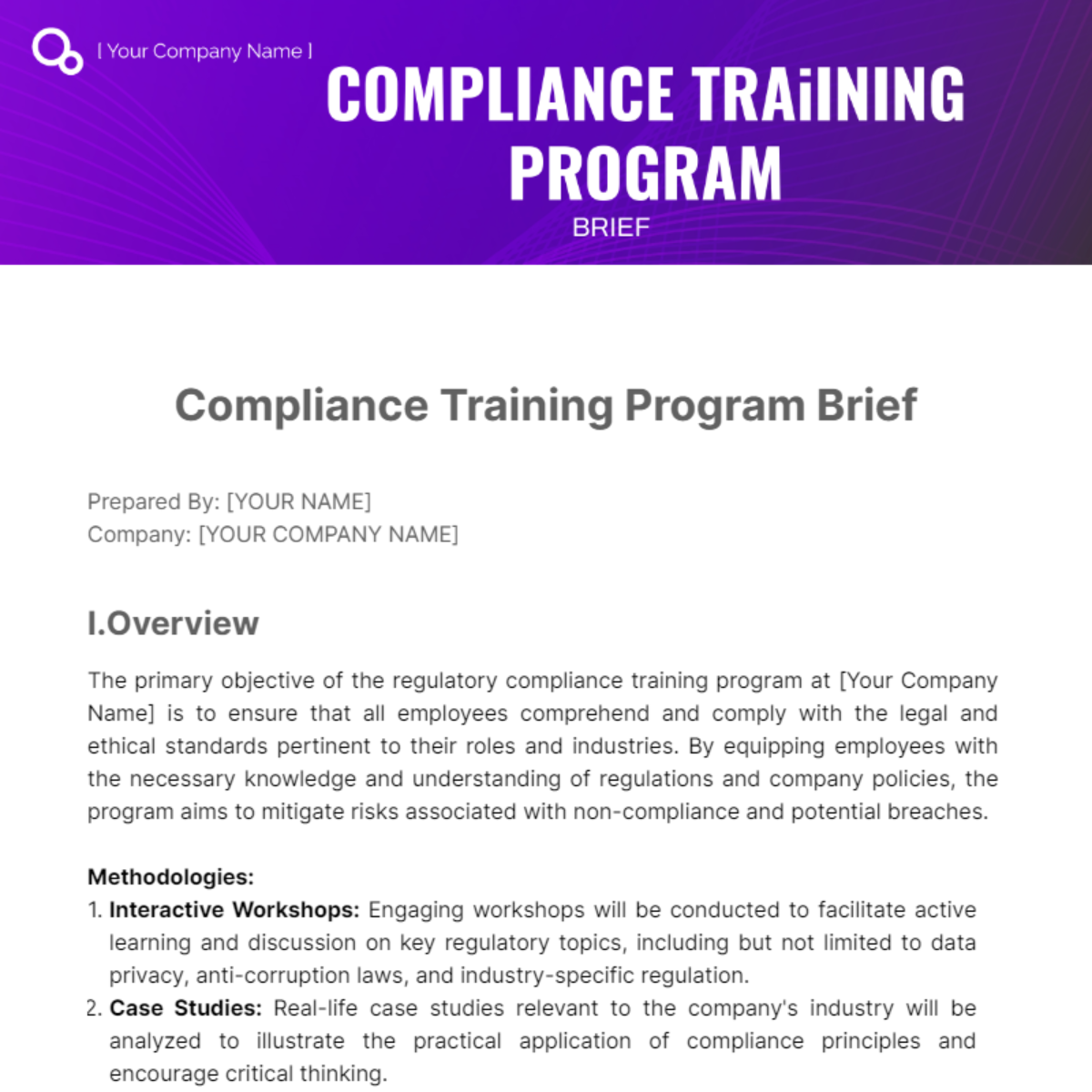Compliance Training Program Brief
Prepared By: [YOUR NAME]
Company: [YOUR COMPANY NAME]
I.Overview
The primary objective of the regulatory compliance training program at [Your Company Name] is to ensure that all employees comprehend and comply with the legal and ethical standards pertinent to their roles and industries. By equipping employees with the necessary knowledge and understanding of regulations and company policies, the program aims to mitigate risks associated with non-compliance and potential breaches.
Methodologies:
Interactive Workshops: Engaging workshops will be conducted to facilitate active learning and discussion on key regulatory topics, including but not limited to data privacy, anti-corruption laws, and industry-specific regulation.
Case Studies: Real-life case studies relevant to the company's industry will be analyzed to illustrate the practical application of compliance principles and encourage critical thinking.
Online Modules: Accessible e-learning modules will provide employees with flexibility in completing training at their own pace while covering essential compliance topics.
Assessments: Regular assessments and quizzes will be administered to evaluate employees' understanding and retention of compliance concepts.
Expert Presentations: Subject matter experts will deliver presentations on specialized compliance areas, offering insights and updates on regulatory changes.
Logistics:
Duration: The training program will span [insert duration], comprising various sessions and activities tailored to different departments and roles within the organization.
Delivery Format: A combination of in-person and virtual training sessions will be conducted to accommodate diverse learning preferences and operational requirements.
Schedule: Training sessions will be scheduled periodically throughout the year to ensure ongoing education and reinforcement of compliance principles.
Resources: Comprehensive training materials, including handbooks, reference guides, and online resources, will be provided to supplement learning and serve as ongoing references for employees.
II. Objectives
Enhance employee understanding and adherence to legal, regulatory, and company policy requirements
Equip employees with the knowledge and skills to recognize and manage compliance-related issues
Support the company in fostering a culture of integrity and ethical behavior
Reduce the risks of compliance violations and associated legal and reputational repercussions
Promote transparency and consistency in adherence to regulatory standards across all departments
III. Training Content
The curriculum for the compliance training program will include, but not limited to, the following modules:
Module
| Description
|
|---|
Ethics and Conduct
| Covers the company’s ethical guidelines and expected professional behavior.
|
Data Privacy and Protection
| Provides understanding on laws and regulations regarding data privacy, confidentiality, and cybersecurity.
|
Anti-Money Laundering
| Gives insights into spotting indicators of money laundering and the actions to take when such sighting occurs.
|
Corporate Social Responsibility
| Enhances understanding and commitment to the company’s responsibility towards the community and environment.
|
IV. Target Audience
The target audience for the training program includes:
Full-Time Employees: This group comprises individuals who are employed on a full-time basis within the organization. They may hold various positions and roles across different departments or functions.
Part-Time Employees: These are individuals who work for the organization on a part-time basis. They may have other commitments or responsibilities outside of their employment with the organization.
Contract Workers: This category includes individuals who are hired on a contractual basis to fulfill specific tasks or projects within the organization. They may not be permanent employees but play a significant role in contributing to the organization's objectives.
Management Personnel: This group consists of individuals who hold managerial or supervisory positions within the organization. They are responsible for leading teams, making strategic decisions, and ensuring the efficient operation of their respective departments or areas of responsibility.
Board Members: Board members are individuals who have been appointed or elected to serve on the organization's board of directors. They typically provide oversight, guidance, and strategic direction to the organization, ensuring alignment with its mission and objectives.
V. Methodologies
In-person Training Sessions:
Conducted in physical settings where trainers interact directly with participants.
Facilitates hands-on learning, immediate feedback, and real-time interactions.
Enables group discussions, role-playing exercises, and demonstrations.
Web-based e-Learning Modules:
Utilizes online platforms to deliver interactive learning content.
Allows participants to learn at their own pace and convenience.
Incorporates multimedia elements such as videos, quizzes, and simulations to enhance engagement and comprehension.
Provides accessibility and flexibility for remote learners.
Practical Activities and Assessments:
Includes hands-on exercises, simulations, and real-world scenarios to reinforce learning objectives.
Enables participants to apply theoretical knowledge to practical situations.
Assessments gauge understanding and track progress, ensuring mastery of key concepts.
Case Study Discussions:
Analyzes real-life cases relevant to the training content.
Encourages critical thinking and problem-solving skills.
Facilitates group discussions to explore different perspectives and solutions.
Guest Speakers and Experts:
Invites industry professionals and subject matter experts to share insights and experiences.
Provides practical insights and real-world examples from seasoned professionals.
Enhances credibility and enriches the learning experience by exposing participants to diverse viewpoints.
VI. Expected Outcomes
Through the successful implementation of the compliance training program, we expect to achieve the following outcomes:
Increased understanding and adherence to legal and company regulations among employees
Improved risk management related to regulatory compliance
Enhanced company reputation and integrity
Strengthened company culture of ethical behavior and transparency
Fewer instances of compliance breaches and violations
VII. Logistical Considerations
In order to implement the compliance training program effectively, the following logistical aspects will be considered:
Scheduling: Timing of training sessions to minimize disruption to regular work
Venue: Selection of conducive environments for in-person sessions
Resources: Necessary training materials, resources, and technology
Budget: Allocation of sufficient budgetary resources to implement the training
Support: Ongoing support and updates for web-based learning portals
Brief Templates @ Template.net






























